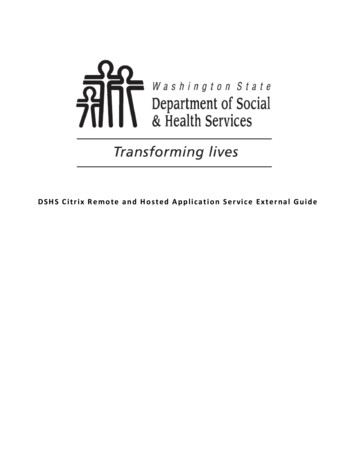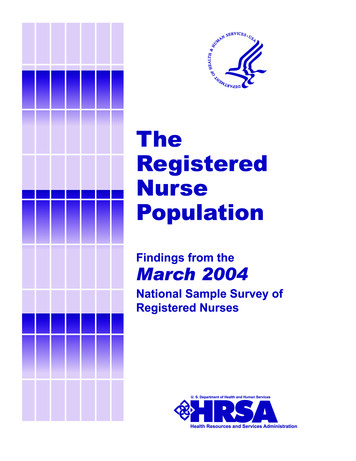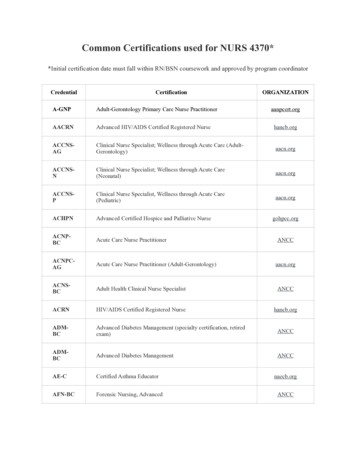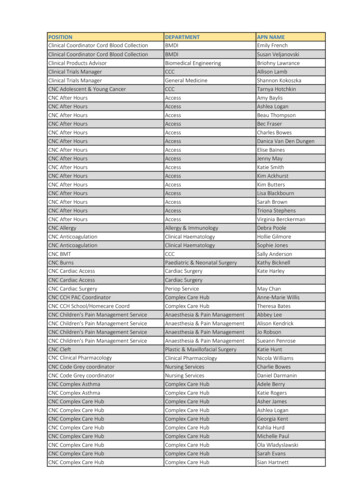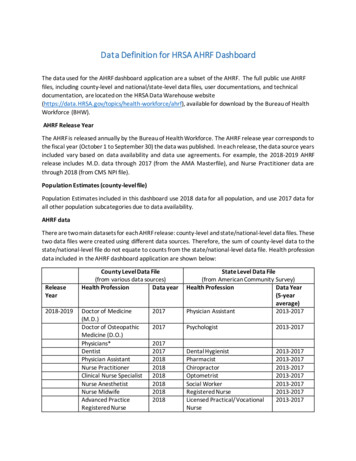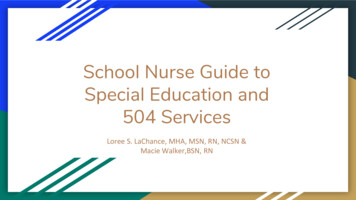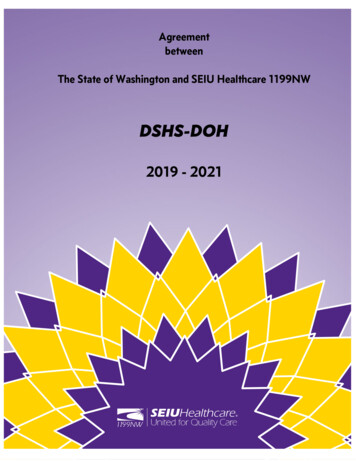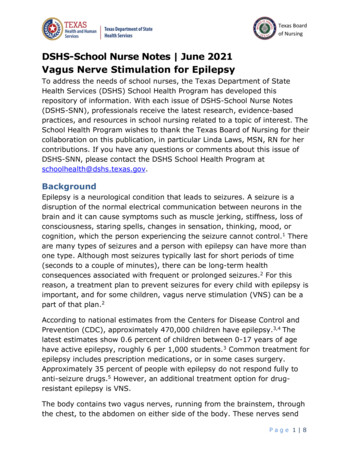
Transcription
TEXASHealth and HumanServicesDepartment of StateI TexasHealth ServicesTexas Boardof NursingDSHS-School Nurse Notes June 2021Vagus Nerve Stimulation for EpilepsyTo address the needs of school nurses, the Texas Department of StateHealth Services (DSHS) School Health Program has developed thisrepository of information. With each issue of DSHS-School Nurse Notes(DSHS-SNN), professionals receive the latest research, evidence-basedpractices, and resources in school nursing related to a topic of interest. TheSchool Health Program wishes to thank the Texas Board of Nursing for theircollaboration on this publication, in particular Linda Laws, MSN, RN for hercontributions. If you have any questions or comments about this issue ofDSHS-SNN, please contact the DSHS School Health Program atschoolhealth@dshs.texas.gov.BackgroundEpilepsy is a neurological condition that leads to seizures. A seizure is adisruption of the normal electrical communication between neurons in thebrain and it can cause symptoms such as muscle jerking, stiffness, loss ofconsciousness, staring spells, changes in sensation, thinking, mood, orcognition, which the person experiencing the seizure cannot control.1 Thereare many types of seizures and a person with epilepsy can have more thanone type. Although most seizures typically last for short periods of time(seconds to a couple of minutes), there can be long-term healthconsequences associated with frequent or prolonged seizures.2 For thisreason, a treatment plan to prevent seizures for every child with epilepsy isimportant, and for some children, vagus nerve stimulation (VNS) can be apart of that plan.2According to national estimates from the Centers for Disease Control andPrevention (CDC), approximately 470,000 children have epilepsy.3,4 Thelatest estimates show 0.6 percent of children between 0-17 years of agehave active epilepsy, roughly 6 per 1,000 students.3 Common treatment forepilepsy includes prescription medications, or in some cases surgery.Approximately 35 percent of people with epilepsy do not respond fully toanti-seizure drugs.5 However, an additional treatment option for drugresistant epilepsy is VNS.The body contains two vagus nerves, running from the brainstem, throughthe chest, to the abdomen on either side of the body. These nerves sendPage 1 8
DSHS-School Nurse Notes June 2021information from the brain to other areas of the body and carry informationback from the body to the brain. Vagus nerve stimulator devices aresurgically implanted in the left upper chest and send electrical pulses alongthe vagus nerve to the brain, which can help to stop or prevent seizures.3While VNS is not a cure for epilepsy or meant to replace traditionaltreatments, it can reduce seizure frequency and intensity and improve moodand quality of life.5 Certain types of vagus nerve stimulators require the useof a special magnet to be trigger the device during a seizure, thereforeschool nurses should be trained to assist students that require VNS as a partof their seizure treatment plan.Nursing Standards and License ConsiderationsThe mission of the BON is to protect and promote the welfare of the peopleof Texas by ensuring that each person holding a license as a nurse in theState of Texas is competent to practice safely. The Board fulfills its missionthrough the regulation of the practice of nursing and the approval of nursingeducational programs. The Board licenses nurses and regulates nurses in theState; the Board does not have purview over practice areas, facilityoperations, or most facility policies and procedures.The Nursing Practice Act (NPA) and Board rules and regulations are writtenbroadly so all nurses can apply them in various practice settings across theState. Because each nurse has a different background, knowledge, and levelof competence, the Board does not have an all-purpose list of tasks thatevery nurse can or cannot perform, and it is up to each individual nurse touse sound judgment when deciding whether or not to perform any particularprocedure or act.The NPA defines legal scope of practice for both the professional nursing(Registered Nurse [RN] level of licensure) and vocational nursing (LVN levelof licensure) in NPA sections 301.002(2) &(5). The NPA describes a definedlimit to nursing practice, as nursing practice “does not include acts ofmedical diagnosis or the prescription of therapeutic or correctivemeasures” [NPA Sec. 301.002(2)&(5)]. Professional and vocational nursingrequires the acts/procedures being performed be within the scope of thatparticular nurses’ practice and appropriate orders be in place for acts that gobeyond the practice of nursing. Resources providing a comprehensivedescription of the LVN scope of practice and the RN scope of practice can bePage 2 8
DSHS-School Nurse Notes June 2021reviewed on the BON website. A nurse must follow the NPA and Board ruleswhen practicing nursing regardless of the setting.Board Rule 217.11 Standards of Nursing Practice is an important referencefor nurses in making a scope of practice determination as it outlines theminimum standards of nursing practice applicable to all levels of licensure(LVN, RN, and APRN). Although Board staff recommend reading this rule inits entirety, in part, this rule states: (1)(A)- know and conform to the Texas NPA and the board’s rules andregulations as well as all federal, state, or local laws, rules orregulations affecting the nurse’s current area of nursing practice;o A nurse is responsible for knowing and complying with anyapplicable regulations related to their area of practice; however,Board staff cannot speak to the laws/rules of other agencies orregulatory bodies.(1)(B)- Implement measures to promote a safe environment for clientsand others;(1)(C)-Know the rationale for and the effects of medications andtreatments and shall correctly administer the same;(1)(D)- Accurately and completely report and document the client’sstatus, including signs and symptoms; nursing care rendered;physician, dentist or podiatrist orders; administration of medicationsand treatments; client response(s); and contacts with other healthcare team members concerning significant events regarding client’sstatus;(1)(F)- Promote and participate in education and counseling to aclient(s) and, where applicable, the family/significant other(s)based onhealth needs;(1)(G)- Obtain instruction and supervision as necessary whenimplementing nursing procedures or practices;(1)(H)- Make a reasonable effort to obtain orientation/training forcompetency when encountering new equipment and technology orunfamiliar care situations;(1)(R)- Be responsible for one’s own continuing competence in nursingpractice and individual professional growth;(1)(M)-Institute appropriate nursing interventions that might berequired to stabilize a client ‘s condition and/or prevent complications;(1)(O)-Implement measures to prevent exposure of infectiouspathogens and communicable conditions;(1)(Q)- Consult with, utilize, and make referrals to appropriatecommunity agencies and health care resources to provide continuity ofcare; andPage 3 8
DSHS-School Nurse Notes June 2021 (1)(T)- Accept only those nursing assignments that take intoconsideration client safety and that are commensurate with the nurse’seducational preparation, experience, knowledge, and physical andemotional ability.Additionally, Board staff recommend reading the following: Position Statement 15.14 (Duty of a Nurse in any Practice Setting)because it uses a landmark court case to demonstrate how everynurse has a duty to promote patient safety, and this duty to a patientsupersedes any physician order or facility policy, andPosition Statement 15.13 (Role of LVNs & RNs in School Health) whichdiscusses the role of the LVN and RN in school health.o Including information related to an RN’s delegation decision, toan unlicensed person, the emergency administration ofmedications or treatments.On a final note, the Board’s Scope of Practice Decision-Making Model (DMM)is a step-by-step tool all nurses practicing in Texas can use to determine ifany given task/procedure is within their individual scope of practice. TheDMM is designed to be used in sequence, beginning at the top with questionnumber one. In the model, nurses are asked reflective questions, anddepending on how they answer, they are directed to continue through themodel or stop. As nurses progress through the model, they can alsoreference professional nursing organizations or specialty associations toassist in determining the standard of care in the setting described and/or thenurse’s individual scope of practice. At any point, if a nurse reaches a StopSign, he/she should consider the activity or intervention in question beyond(or outside) his/her scope of practice. For example, the nurse may wish toconsider if the act or procedure is consistent with current nursing evidencebased practice guidelines, and prevailing nursing standards of care.Texas Board of Nursing (BON) Resources1. Nursing Practice Act, Nursing Peer Review & Nurse Licensure Compact:Occupations Code and Statutes Regulating the Practice of Nursing. AsAmended September 2019.2. Rules and Regulations relating to Nurse Education, Licensure andPractice. Published October 2019.Page 4 8
DSHS-School Nurse Notes June 20213. Position Statement: 15.14 Duty of a Nurse in any Practice Setting 15.13 Role of LVNs and RNs in School Health4. Scope of Practice Decision-Making ModelNational Association of School Nurses (NASN) Code of Ethics Position Brief (2018): Wearable Medical Technology in Schools- TheRole of the School Nurse Position Statement (2018): IDEIA and Section 504 Teams- The SchoolNurse as an Essential Team Member Position Statement (2017): Students with Chronic Health Conditions:The Role of the School NurseTexas School Nurses Organization (TSNO) School Nursing: Scope and Standards of PracticeResearchThe following articles come from a review of the scientific literature. Forassistance in obtaining an article, please contact the DSHS Library atlibrary@DSHS.texas.gov and mention inclusion of the requested article inthe DSHS-School Nurse Notes. Following each citation is a portion of thearticle’s abstract or a summary of the article.1. Johnson R, Wilson C. A review of vagus nerve stimulation as atherapeutic intervention. Journal of Inflammation Research.2018;11 203–213Vagus Nerve Stimulation (VNS) is currently FDA approved fortherapeutic use in patients aged 12 years with drug-resistantepilepsy and depression. Recent studies of VNS in in vivo systemshave shown that it has anti-inflammatory properties which has led tomore preclinical research aimed at expanding VNS treatment across awider range of inflammatory disorders. This article provides anoverview of the US Food and Drug Administration (FDA)-approvedclinical uses of vagus nerve stimulation (VNS) as well as informationabout the ongoing studies and preclinical research to expand the useof VNS to additional applications.2. Roesler M, Obst B. Hidden Devices in the School Setting: Whatthe School Nurse needs to know about vagus nerve stimulation.Page 5 8
DSHS-School Nurse Notes June 2021Sage Journal, NASN School Nurse. 2019; 34(5), 257-261.DOI:10.1177194260Vagus nerve stimulation involves an implanted medical device used todeliver electrical pulses to the vagus nerve for additional seizuremanagement. The school nurse needs to understand the purpose andfunction of the hidden medical device, including the parameters for useof the device and magnet, safety considerations, and side effects.SHNIC has developed educational materials specific to vagus nervestimulation to aid the school nurse in providing staff training,developing care plans, and creating a safe school experience forstudents with special health needs.3. Fan H-C, Hsu T-R, Chang K-P, Chen S-J, Tsai J-D. Vagus nervestimulation for 6- to 12-year-old children with refractoryepilepsy: Impact on seizure frequency and parenting stressindex. Epilepsy & Behavior. 2018;(83)119-123.Refractory epilepsy (RE) is frequently associated withneuropsychological impairment in children and may disrupt their socialdevelopment. Vagus nerve stimulation (VNS) had been reported tohave beneficial effects on behavioral outcomes. The aim of this studywas to compare Parenting Stress Index (PSI) scores before and afterVNS device implantation in children with RE. Seizure frequency andPSI were measured before VNS implantation and 12 months after in agroup of school-aged children. Treatment with VNS was significantlyassociated with reduced seizure frequency and improved PSI scores,especially within the child domain on the mood and reinforces parentsubscales.4. Terry D, Patel AD, Cohen DM, Scherzer D, Kline J. Barriers toSeizure Management in Schools. Journal of Child Neurology. 2016;31(14)1602-1606.The purpose of this study was to assess school nurses’ perceptions ofbarriers to optimal management of seizures in schools. Eighty-threeschool nurses completed an electronic survey. Most agreed they feltconfident they could identify a seizure, give rectal diazepam, andhandle cluster seizures; but fewer were confident they could giveintranasal midazolam, had specific information about a student’sPage 6 8
DSHS-School Nurse Notes June 2021seizures, or could swipe a vagus nerve stimulator magnet. Nurseswere more likely to be available at the time of a seizure in rural versussuburban or urban schools. School nurses are comfortable managingseizures in the school setting. However, a specific seizure plan for eachchild and education on intranasal midazolam and vagus nervestimulator magnet use is essential.ResourcesGeneral Information Centers for Disease Control and Prevention (CDC): Epilepsy Citizens United for Research in Epilepsy: About Epilepsy Texas Department of State Health Services (DSHS) and Texas Health andHuman Services (HHS): School Health Services: Nursing Practice Resources-IndividualizedHealthcare Plans - Seizures IHP Texas Guide to School Health Services: Health Conditions-Epilepsyand Seizures Texas Health and Human Services - Epilepsy Program Epilepsy Foundation: A Quick Reference Guide for School Nurses: Managing Studentswith Seizures Recommendations for Care of Children with Epilepsy Treating Seizures and Epilepsy Placement, Programming and Safety of Vagus Nerve Stimulation Vagus Nerve Stimulation National Association of School Nurses (NASN): School Nurse Evidence-based Practice Clinical Guideline: Studentswith Seizure and Epilepsy National Association of Epilepsy Centers: Patient Resources Kennedy Krieger Institute: Fact Sheet: Vagus Nerve StimulatorContinuing Education CDC Training for Professionals EpilepsyFirst Responder Training Epilepsy FoundationSeizure Training for School Personnel Epilepsy FoundationManaging Students with Seizures Program for School Nurses EpilepsyFoundationBooks for Purchase Epilepsy Foundation: Books about Epilepsy Pellock’s Pediatric Epilepsy: Diagnosis and Therapy, 4th EditionPage 7 8
DSHS-School Nurse Notes June 2021References1. American Academy of Neurology. Vagus Nerve Stimulation the Treatment forEpilepsy. l/618Updated July 20, 2019. Accessed April 5, 2021.2. Joshi SM, Singh RK, Shellhaas RA. Advanced Treatments for ChildhoodEpilepsy: Beyond Antiseizure Medications. JAMA Pediatr. 3.4243. Zack MM, Kobau R. National and state estimates of the numbers of adults andchildren with active epilepsy — United States, 2015. MMWR. 2017; 66:821–825. DOI: 10.15585/mmwr.mm6631a1.4. Centers of Disease Control and facts.htm Updated September 30,2020. Accessed April 5, 2021.5. Mayoclinic.org. Vagus nerve stimulation - Mayo /vagus-nervestimulation/about/pac-20384565. Updated November 17, 2020. AccessedApril 7, 2021.For assistance in obtaining any resources, please contact the DSHS Libraryat library@DSHS.texas.gov and mention inclusion of the requested resourcein the DSHS-School Nurse Notes.External links to other sites and products appearing here are intended to be informational and donot represent an endorsement by the DSHS. These sites may also not be accessible to peoplewith disabilities. External email links are provided to you as a courtesy. Please be advised thatyou are not emailing the DSHS, and DSHS policies do not apply should you choose to correspond.For information about any of the initiatives listed, contact the sponsoring organization directly.Copyright free. Permission granted to forward or make copies in its entirety as needed.Page 8 8
To address the needs of school nurses, the Texas Department of State Health Services (DSHS) School Health Program has developed this repository of information. With each issue of DSHS-School Nurse Notes (DSHS-SNN), professionals receive the latest research, evidence-based practices, and resources in school nursing related to a topic of interest .
